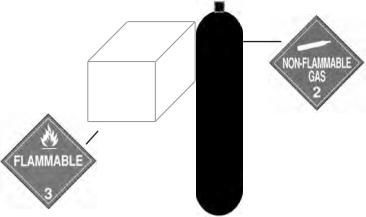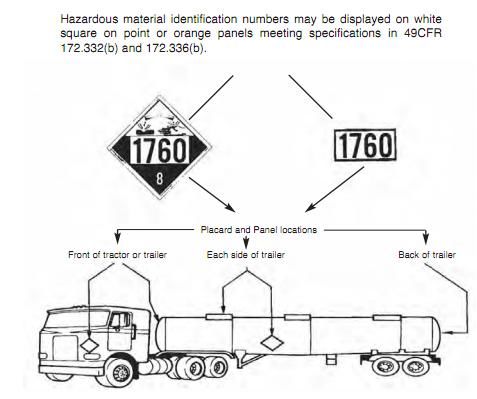Review Questions - Click On The Picture To Begin...

- Use a larger size sheet of paper for the hazmat items
- Be printed on a bright orange sheet of paper
- Have "HAZMAT" written on the top of the shipping papers
- Be kept on top of other shipping papers
Quote From The CDL Manual:
Rules require:
- Shippers to describe hazardous materials correctly and include an emergency response telephone number on shipping papers.
- Carriers and drivers to put tabs on hazardous materials shipping papers, or keep them on top of other shipping papers and keep the required emergency response information with the shipping papers.
- Drivers to keep hazardous materials shipping papers:
- In a pouch on the driver's door, or
- In clear view within immediate reach while the seat belt is fastened while driving, or
- On the driver's seat when out of the vehicle.
- 4
- 3
- 2
- 5
Quote From The CDL Manual:
Placards are used to warn others of hazardous materials. Placards are signs put on the outside of a vehicle that identify the hazard class of the cargo. A placarded vehicle must have at least four identical placards. They are put on the front, rear and both sides of the vehicle. Placards must be readable from all four directions. They are 10 3/4-inches square, square-on-point, in a diamond shape. Cargo tanks and other bulk packaging display the ID number of their contents on placards, or orange panels or white square-on-point displays that are the same size as placards, and placed near the placards.
TruckingTruth's Advice:
It's good practice to grab an extra placard or two from the shipper in case one of your placards is blown off the truck during transport.
- All packaging containing hazardous materials, regardless of size or shape, must have a diamond-shaped warning label attached
- A label on a tag securely attached to the package
- A brightly colored marker to write "HAZMAT" directly onto the product or packaging
- A small brightly colored piece of paper, such as a sticky note, taped to the package with the hazard type written on it
Quote From The CDL Manual:
Shippers put diamond-shaped hazard warning labels on most hazardous materials packages. These labels inform others of the hazard. If the diamond label will not fit on the package, shippers may put the label on a tag securely attached to the package. For example, compressed gas cylinders that will not hold a label will have tags or decals.
- On the driver's seat when out of the vehicle
- In clear view within immediate reach while the seat belt is fastened while driving
- In a pouch on the driver's door
- All of these are acceptable places to keep shipping papers
Quote From The CDL Manual:
Drivers to keep hazardous materials shipping papers:
- In a pouch on the driver's door, or
- In clear view within immediate reach while the seat belt is fastened while driving, or
- On the driver's seat when out of the vehicle.
- Small stickers placed on the drivers and passengers side window showing the driver has a hazardous materials endorsement
- Seals placed on rear doors of box trailers or output devices on tankers to prevent hazardous materials from leaking
- Signs put on the outside of a vehicle that identify the hazard class of the cargo
- Stickers placed on shipping papers that identify the hazard class of the cargo
Quote From The CDL Manual:
Placards are used to warn others of hazardous materials. Placards are signs put on the outside of a vehicle that identify the hazard class of the cargo. A placarded vehicle must have at least four identical placards. They are put on the front, rear and both sides of the vehicle. Placards must be readable from all four directions. They are 10 3/4-inches square, square-on-point, in a diamond shape. Cargo tanks and other bulk packaging display the ID number of their contents on placards, or orange panels or white square-on-point displays that are the same size as placards, and placed near the placards.
TruckingTruth's Advice:
Always be sure to ask for an extra placard or two when leaving a shipper in case a placard is blown off the truck during transit.
- The sale price of each product
- A seal of hazardous material shipping approval
- An emergency response telephone number
- Hazardous material spill cleanup instructions
Quote From The CDL Manual:
After an accident or hazardous materials spill or leak, you may be injured and unable to communicate the hazards of the materials you are transporting. Firefighters and police can prevent or reduce the amount of damage or injury at the scene if they know what hazardous materials are being carried. Your life, and the lives of others, may depend on quickly locating the hazardous materials shipping papers. For that reason, the rules require:
- Shippers to describe hazardous materials correctly and include an emergency response telephone number on shipping papers.
- Carriers and drivers to put tabs on hazardous materials shipping papers, or keep them on top of other shipping papers and keep the required emergency response information with the shipping papers.
- Drivers to keep hazardous materials shipping papers:
- In a pouch on the driver's door, or
- In clear view within immediate reach while the seat belt is fastened while driving, or
- On the driver's seat when out of the vehicle.
- Rectangle
- Triangle
- Diamond
- Square
Quote From The CDL Manual:
Placards are used to warn others of hazardous materials. Placards are signs put on the outside of a vehicle that identify the hazard class of the cargo. A placarded vehicle must have at least four identical placards. They are put on the front, rear and both sides of the vehicle. Placards must be readable from all four directions. They are 10 3/4-inches square, square-on-point, in a diamond shape. Cargo tanks and other bulk packaging display the ID number of their contents on placards, or orange panels or white square-on-point displays that are the same size as placards, and placed near the placards.









 TT On Facebook
TT On Facebook